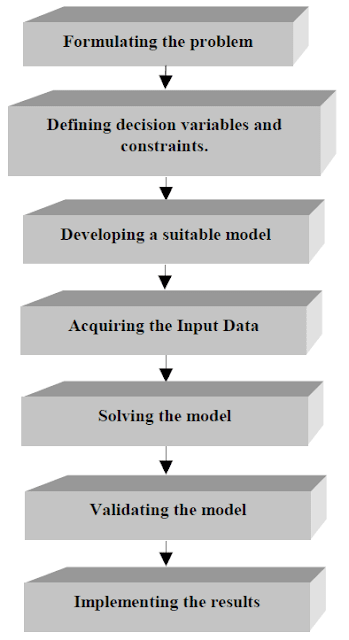METHODOLOGY OF QUANTITATIVE TECHNIQUES
The methodology adopted in solving problems is as follows:
Formulating the Problem
As a first step, it is necessary to clearly understand the problem situations. It is important to know how it is characterized and what is required to be determined.
Initially it is important to identify the key decision and the objective from the problem.Then, it involves determination of the number of decision variables and the relationship between variables. The measurable guaranties that are represented through these variables are notified.Finally the practical limitations or constraints are also inferred from the problem.
Defining the Decision Variables and Constraints
In a given problem situation, defining the key decision variables are important. Identifying these variables helps us to develop the model. For example, consider a manufacturer who is manufacturing three products A, B and C using two machines, I and II. Each unit of product A takes 2 minutes on machine I and 5 minutes on machine II. Product B takes 1 minute on machine I and 3 minutes on machine II.
Similarly, product C takes 4 minutes and 6 minutes on machine I and machine II, respectively. The total available time on machine I and machine II are 100 hours and 120 hours, respectively. Each unit of A yields a profit of Rs. 3.00, B yields Rs. 4.00 and C yields Rs. 5.00. What should be level of production of products A, B and C that should be manufactured by the company so as to maximize the profit?
The decision variables, objective and constraints are identified from the problem.
The company is manufacturing three products A, B and C. Let A be x1, B be x2 and C be x3. x1, x2 and x3 are the three decision variables in the problem. The objective is to maximize the profits. Therefore, the problem is to maximize the profit, i.e., to know how many units of x1, x2 and x3 are to be manufactured. There are two machines available, machine I and machine II with total machine hours available as 100 hours and 120 hours. The machine hours are the resource constraints, i.e., the machines cannot be used more than the given number of hours.
To summarize,
Key decision : How many units of x1, x2 and x3 are to be manufactured? Decision variables : x1, x2 and x3 Objective : To maximize profit Constraint : Machine hours
Developing a Suitable Model
A model is a mathematical representation of a problem situation. The mathematical model is in the form of expressions and equations that replicate the problem. For example, the total profit from a given number of products sold can be determined by subtracting selling price and cost price and multiplying the number of units sold. Assuming selling price, sp as Rs. 40 and cost price, cp as Rs. 20, the following mathematical model expresses the total profit, tp earned by selling number of unit x.
T P = (SP – CP) x = (40 – 20) x T P = 20 x
Now, this mathematical model enables us to identify the real situation by understanding the model. The models can be used to maximize the profits or to minimize the costs. The applications of models are wide, such as:
Linear Programming ModelInteger ProgrammingSensitivity AnalysisGoal ProgrammingDynamic ProgrammingNon Linear ProgrammingQueuing TheoryInventory Management TechniquesPERT/CPM (Network Analysis)Decision TheoryGames TheoryTransportation and Assignment Models.
Acquiring the Input Data
Acquiring accurate data for input values are essential. Even though the model is a perfect representation of reality, improper data will result in misleading results. Collecting accurate data can be one of the most difficult steps in performing quantitative analysis.
Solving the Model
Solving the model involves manipulating the model to arrive at the optimal solution. In some cases, this requires that an equation be solved for the best decision. In other cases, you can use a trial and error method, trying various approaches and picking the one that results in the best solution
Validating the Model
A validation is a complete test of the model to confirm that it provides an accurate representation of the real problem. This helps us in determining how good and realistic the solution is. During the model validation process, inaccuracies can be rectified by taking corrective actions, until the model is found to be fit.
Implementing the Results
The final step is to implement the results. This is the process of incorporating the solution into the company. Even if the solution is optimal and will result in millions of dollars in additional profits, if managers resist the new solution, all of the efforts of the analysis are of no value.
After the solution has been implemented, it should be closely monitored. Over time, there may be numerous changes that call for modifications of the original solution. A changing economy, fluctuating demand and model enhancements requested by managers and decision makers are only a few examples of changes that might require the analysis to be modified.

how ca one
ReplyDeleteget the pdf notes